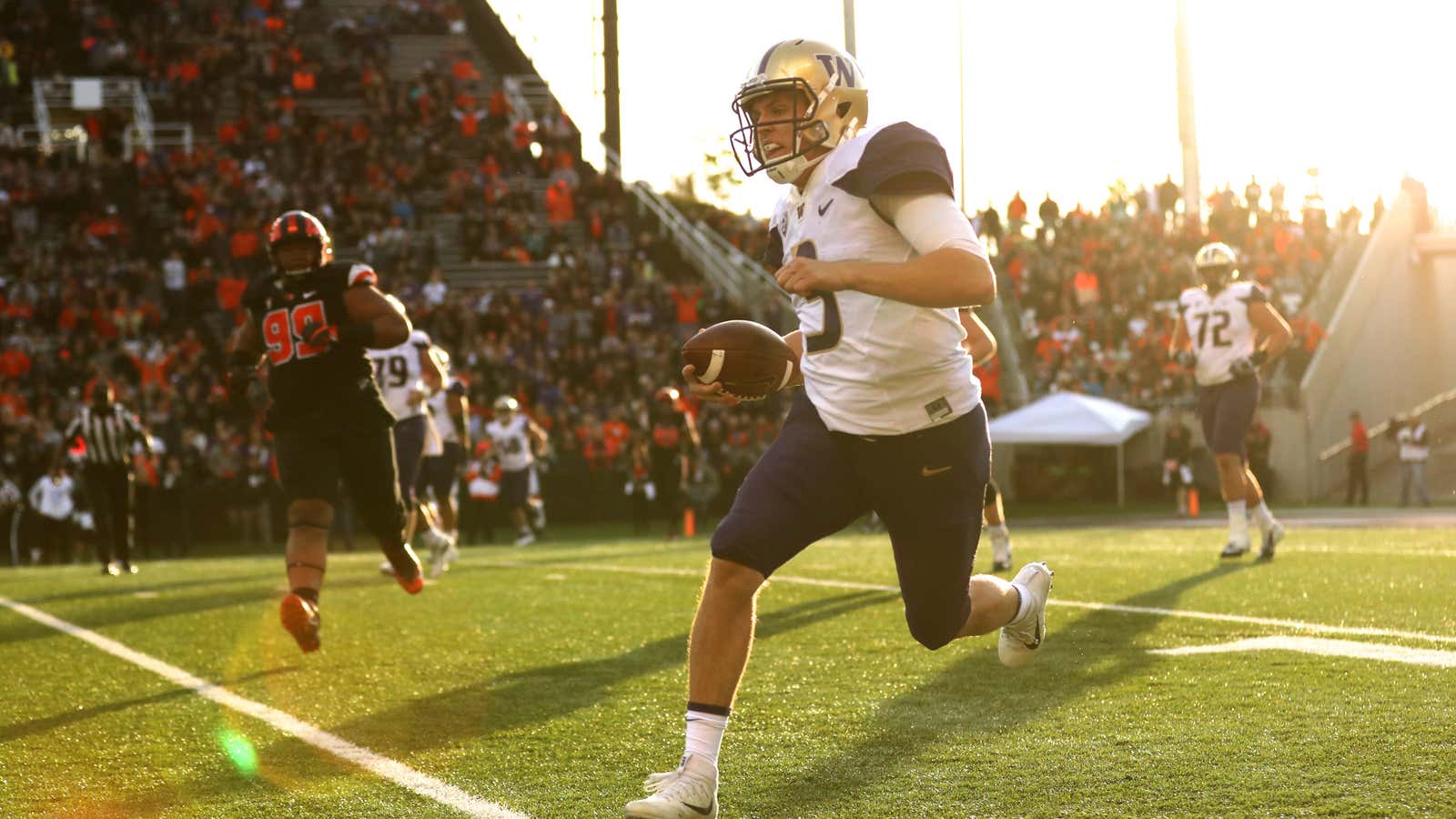College football costs too much. It exploits players and even damages their brains. It glorifies violence and promotes a thuggish brand of masculinity. And it undermines the college’s academic mission.
We hear this a lot, and much of it is true. But consider, for the moment, that football may help explain how the American system of higher education has become so successful. According to rankings computed by Jiao Tong University in Shanghai, American institutions account for 32 of the top 50 and 16 of the top 20 universities in the world. Also, between 2000 and 2014, 49% of all Nobel recipients were scholars at US universities.
The connection between brawny linemen and brainy physicists may seem remote, but it’s really not. In order to support a large number of high-powered professors, US universities need to attract a huge number of tuition-paying students, and they need to turn those students into loyal lifelong donors. In order to draw state appropriations, they also need to extend their reach beyond their own alumni by attracting the political support of citizens in the immediate community and in the state at large. And they need to do so within an extremely competitive higher education market consisting of nearly 5,000 degree-granting institutions.
In doing research for a book about the American system of higher education, I discovered that the key to its strength has been its ability to combine elite scholarship with populist appeal. And football played a key role in creating this alchemy.
American colleges developed their skills at attracting consumers and local supporters in the early nineteenth century, when the basic elements of the higher education system came together.
These colleges emerged in a very difficult environment, when the state was weak, the market strong, and the church divided. Unlike European forebears, who could depend on funding from the state or the established church, American colleges arose as not-for-profit corporations that received only sporadic funding from church denominations and state governments and instead had to rely on students and local donors. Often adopting the name of the town where they were located, these colleges could only survive, much less thrive, if they were able to attract and retain students from nearby towns and draw donations from alumni and local citizens.
Like any other market-based institution, the early college had to develop an attractive brand and to foster, in both students and the broader community, strong loyalty to that brand. Ideally, this meant turning current students into loyal alumni and community members into fervent fans. As public colleges emerged later in the nineteenth century, they followed the lead of the privates in seeking their own sources of support because they too lacked secure public funding.
In this quest, American colleges and universities have been uniquely and spectacularly successful. Go to any American campus and you will see that nearly everyone seems to be wearing the brand—the school colors, the logo, the image of the mascot, team jerseys. Unlike their European counterparts, American students don’t just attend an institution of higher education; they identify with it. It’s not just where they enroll; it’s who they are. In the US, the first question that twenty-year-old strangers ask each other is “Where do you go to college?” And half the time the question is moot because the speakers are wearing their college colors.
Football, along with other intercollegiate sports, has been enormously helpful in building the college brand. It helps draw together all of the members of the college community (students, faculty, staff, alumni, and local fans) in opposition to the hated rival in the big game. It promotes a loyalty that lasts for a lifetime, which translates into a broad political base for gaining state funding and a steady flow of private donations.
Thus one advantage that football brings to the American university is financial. It’s not that intercollegiate sports turn a large profit; in fact, the large majority lose money. Instead, it’s that they help mobilize a stream of public and private funding. And now that state appropriations for public higher education are in steady decline, public universities, like their private counterparts, are increasingly dependent on private funding.
This private support provides American colleges with a degree of autonomy from state control that has given them a big advantage over their international rivals, which are for the most part wholly dependent on government. This autonomy makes the institutions freer from political influence and nimbler in pursuing entrepreneurial opportunities, adapting to changes in the market, and besting their peers.
Another advantage that football brings is that it softens the college’s elitism. Even the most elite American public research universities (Michigan, Wisconsin, Berkeley, UCLA) have a strong populist appeal. The same is true of a number of elite privates (think Stanford, Vanderbilt, Duke, USC). In large part this comes from their role as a venue for popular entertainment supported by their accessibility to a large number of undergraduate students. As a result, the US university has managed to avoid much of the social elitism of British institutions such as Oxford and Cambridge and the academic elitism of the German university dominated by the graduate school. Go to a college town on game day, and nearly every car, house, and person is sporting the college colors.
This broad support is particularly important these days, now that the red-blue political divide has begun to affect colleges as well. A recent study showed that, while most Americans still believe that colleges have a positive influence on the country, 58% of Republicans do not. History strongly suggests that football is going to be more effective than Nobel prizes in winning back their loyalty.
So let’s hear it for college football. It’s worth two cheers at least.
